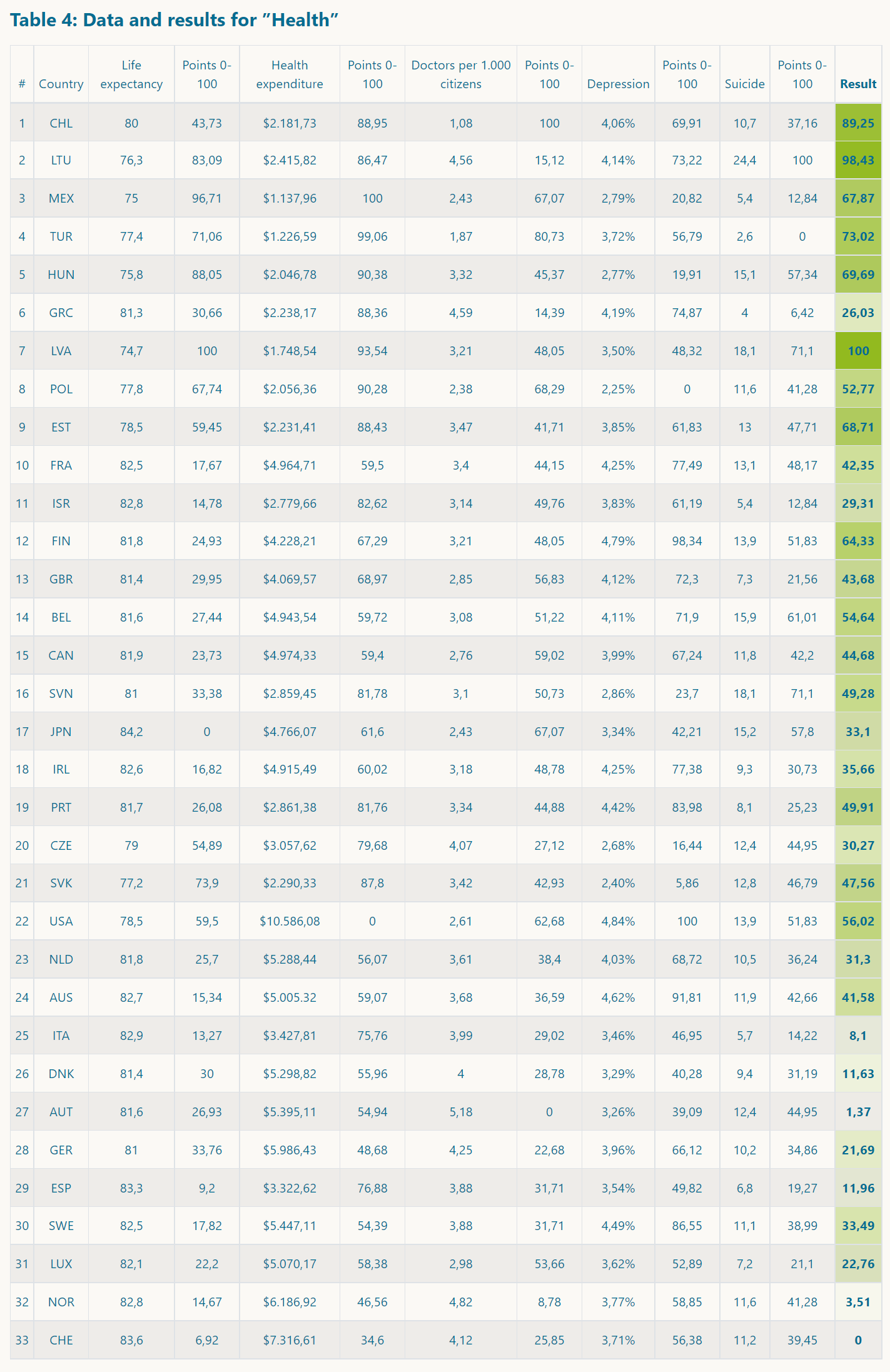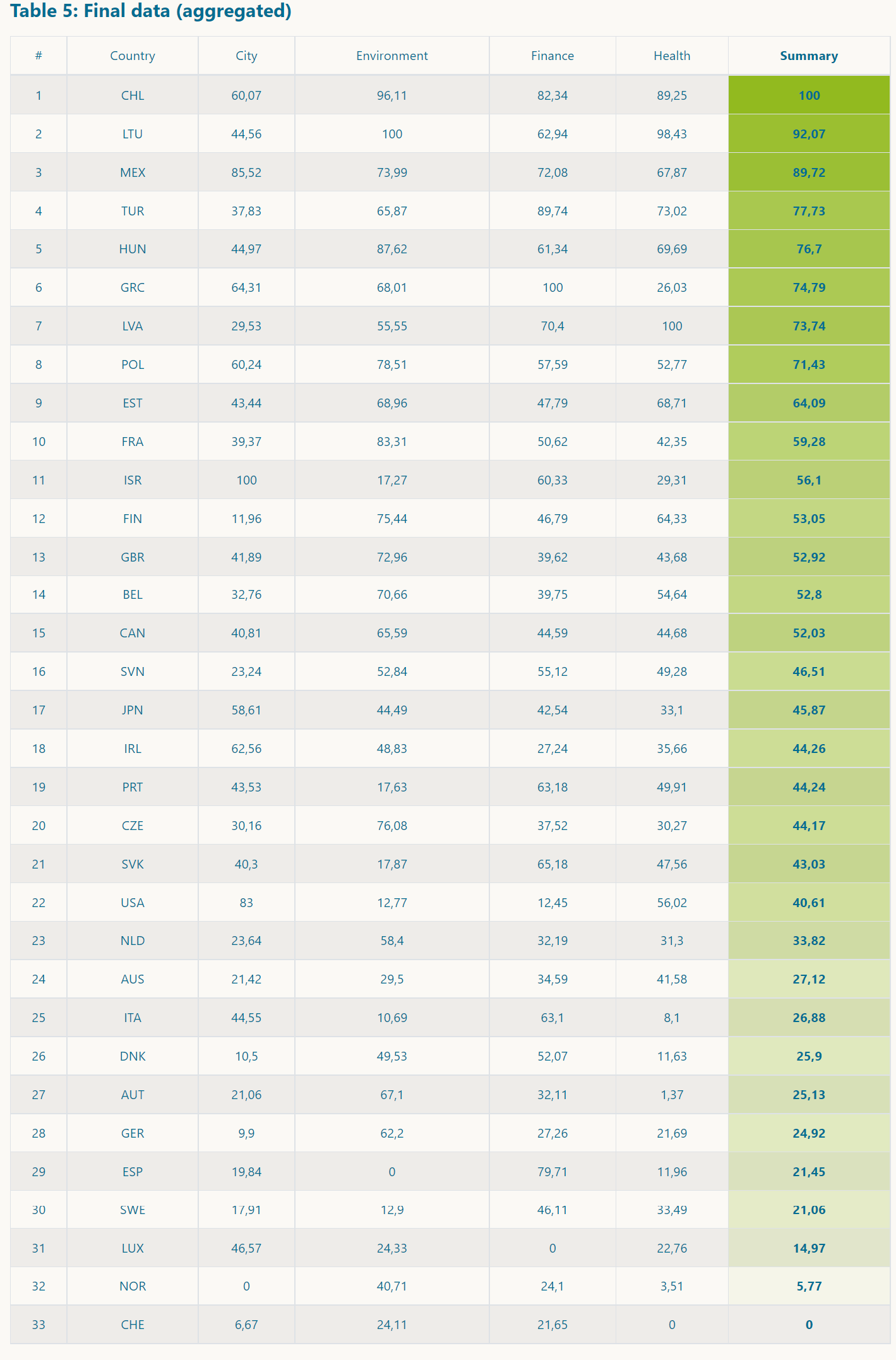
City life influences our everyday life.
Despite major advancements in public transport and urban planning, city life can be exceptionally stressful. There are a huge range of factors that either contribute or ease the burden of everyday urban life, such as the average working hours, the cost of rent, and the hours of sunshine. At Baufi24, we’re proud to be part of the new wave of digitisation that aims to make city life easier. With 68% of the world’s population predicted to live in urban areas by 2050, this study aims to highlight the urgent need for cities to adapt and innovate to meet the demands of their rapidly growing populations (United Nations, 2018).
This study analyses 33 capital cities in the OECD for a range of factors across four categories: City, Environmental, Financial, and Health, to give a comprehensive overview of the various elements of city life that can affect our mental well-being. The factors range from levels of disposable income, unemployment rates, and suicide rates, to the number of doctors per capita, the levels of air pollution, and the percentage of available green space. Santiago ranks first as the most stressful city in the world, while London ranks 14th, ahead of Washington D.C. Tokyo, and Madrid, largely a result of a lack of available green space.
Evaluation result
Methodology: The World’s Most Stressful Cities
This study ranks the capital cities of the countries in the Organisation for Economic Cooperation and Development to identify which urban populations are most exposed to stress. The cities were examined across a selection of fields of investigation, including ‘City’, ‘Environment’, ‘Finance’, and ‘Health’.
Due to a lack of data and in order to ensure comparability, the cities of Bogota (Colombia), Reykjavik (Iceland), Seoul (South Korea) and Wellington (New Zealand) were not included in the analysis.
Field of Investigation 1: City

Population density
Population density and social interaction are proportional to each other. Thus, excessive demands on social interaction generate stress (see The Social Consequences of High Population Density – Halliman H. Winsborough). The information on the average population density of the city (inhabitants per km², 2018) was taken from the data portal OECD.stats.
Rental expenses
People who do not have access to affordable accommodation experience greater levels of stress due to the income required to manage the cost of living (see Housing stress and the mental health and wellbeing of families – Elly Robinson and Rennell Adams). The information on the average monthly rent for a one-room apartment in the city centre was taken from the Numbeo database.
Working hours
Long working hours lead to psychosocial stress in employees (see vgl. Lee K, Suh C, Kim JE, Park JO. The impact of long working hours on psychosocial stress response among white-collar workers. Ind Health. 2017;55(1):46‐53). Average annual working hours (paid work) is taken from Max Roser (2013): "Working Hours", published in Our World In Data.
Traffic congestion
High traffic congestion affects the stress level of drivers (See vgl. Bitkina, Olga Vl et al. “Identifying Traffic Context Using Driving Stress: A Longitudinal Preliminary Case Study.” Sensors (Basel, Switzerland) vol. 19,9 2152. 9 May. 2019). The percentage increase on journey time caused by heavy traffic and congestion was taken from the Tom Tom Traffic Index 2019.
Traffic accidents
Drivers under stress cause more accidents (see vgl. Taylor AH, Dorn L. Stress, fatigue, health, and risk of road traffic accidents among professional drivers: the contribution of physical inactivity. Annu Rev Public Health. 2006;27:371‐391). The data on the number of road traffic accidents per 100,000 inhabitants was taken from the statistics "Road injury accidents" on the data portal OECD.stats from the year 2018.
Field of investigation 2: Environment
%20(1).jpeg)
Sunshine hours
Sunlight promotes the release of the hormone serotonin, which increases our mood and helps is remain calm and focused (see “What Are the Benefits of Sunlight?”, Rachel Nall/ Heathline). Data on the annual average number of hours of sunshine was taken from various sources. All sources are listed on page 4.
Air pollution
Long-term exposure to pollutants has many negative effects, such as increased susceptibility to stress (see Adler T. A complex relationship: psychosocial stress, pollution, and health. Environ Health Perspect. 2009;117(9):A407). The data on the average fine dust pollution (PM2.5) in µg/m³ was taken from the Ambient Air Pollution Database 2016 of the World Health Organization WHO.
Green spaces
Analyses reveals a relationship between the amount of green space in a residential area and levels of stress. A higher proportion of green space is associated with less stress (see Roe JJ, Thompson CW, Aspinall PA, et al. Green space and stress: evidence from cortisol measures in deprived urban communities. Int J Environ Res Public Health. 2013;10(9):4086‐4103). The data on the percentage of green space in the city studied was taken from various sources. All sources are listed on page 4.
Field of investigation 3: Finances
.jpeg)
Unemployment
Unemployment and financial insecurity can promote psychosomatic symptoms, depression and anxiety (see Linn MW, Sandifer R, Stein S. Effects of unemployment on mental and physical health. Am J Public Health. 1985;75(5):502‐506). The data on national unemployment rates for the first quarter of 2020 were taken from the unemployment statistics of the OECD data portal.
Gross Domestic Product
Gross domestic product provides information on the standard of living of a society (see “How well GDP measures the well-being of society?”: Khan Academy). The GDP per capita in US dollars was taken from the statistics "Level of GDP per capita and productivity" of the data portal OECD.stats from 2019.
Income
A low household income is associated with several lifelong mental disorders and suicide attempts. A reduction in household income is associated with an increased risk of incidents of mental disorders (see Sareen J, Afifi TO, McMillan KA, Asmundson GJG. Relationship Between Household Income and Mental Disorders: Findings From a Population-Based Longitudinal Study. Arch Gen Psychiatry. 2011;68(4):419–427). The average annual income at the national level in US dollars was taken from the statistics "Household disposable income" of the OECD data portal from 2018.
Field of investigation 4: Health

Life expectancy
Life expectancy is influenced not only by the traditional risk factors associated with lifestyle but also by factors related to a person's quality of life, such as severe stress (National Institute for Health and Welfare. "Heavy stress and lifestyle can predict how long we live." ScienceDaily. ScienceDaily, 11 March 2020). The information on average life expectancy at a national level was taken from World Bank data from 2018.
Doctors
Comprehensive medical care increases the quality of life and allows the early diagnosis and treatment of stress symptoms. The information on the number of doctors per 1,000 inhabitants was taken from the statistics on "Doctors" of the OECD data portal in 2018.
Health expenditure
Comprehensive health care improves the quality of life and allows early diagnosis and treatment of stress symptoms. The data on the level of public health expenditure per inhabitant in 2018 was taken from the statistics on "Health Spendings" of the OECD's data portal.
Depression
Environmental factors, such as stress, can be the cause of the onset of depression (see Yang L, Zhao Y, Wang Y, et al. The Effects of Psychological Stress on Depression. Curr Neuropharmacol. 2015;13(4):494‐504). The data on the percentage of the population suffering from depression was taken from Hannah Ritchie and Max Roser (2018): "Mental Health" published in Our World In Data.
Suicide
Depression is one of the most common causes of suicide (see Teismann, T., et al. Positive mental health moderates the association between depression and suicide ideation: A longitudinal study. International Journal of Clinical and Health Psychology, 2017). Environmental factors, such as stress, can be the cause of the onset of depression. The data on the national suicide rate (suicides per 100,000 inhabitants) was taken from the statistics "Suicide rates" of the OECD data portal from 2018.
Calculation
In order to enable a comparison, all the results were standardised on scale from 0 to 100. The city with the highest score in each factor received a score of 100, and the city with the lowest score in each factor received a score of 0. The result for one field of investigation was the sum of the points of all influencing factors in that field.
For example, the evaluation result for the field of investigation 1, City, was the sum of the standardised results of the influencing factors, which included: population density, rent, traffic jams, traffic accidents, and working hours. The results for each city were also standardised in order to enable comparability between the cities.
The following normalisation formula was used for the standardisations:







